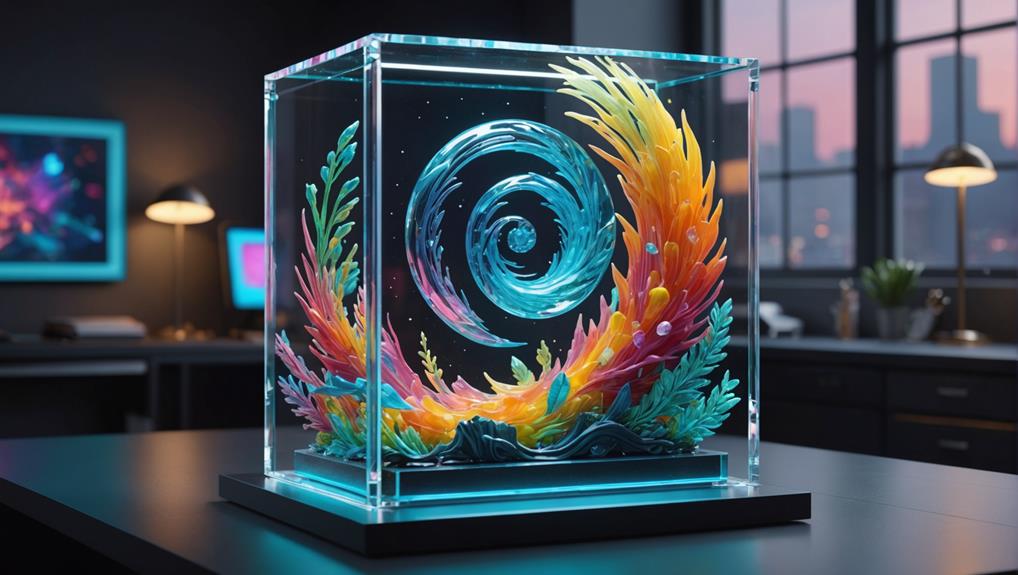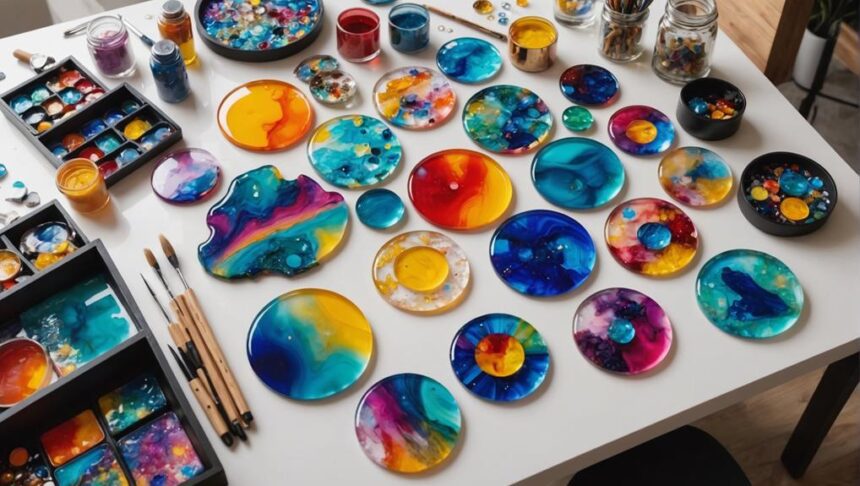3D resin art is an awe-inspiring way to create eye-popping artworks by pouring liquid resin into molds, making anything from jewelry to stunning sculptures. Imagine embedding flowers or shells inside, giving your art a cool, layered look! It’s super trendy now because epoxy resin is easy to get, and platforms like TikTok are bursting with mind-blowing resin projects. Plus, workshops and online tutorials make it easy for even newbies to get started. Safety gear and the right tools are essential, though, because resin can be tricky. Stick around to discover how this fascinating art form is evolving!
Key Takeaways
- 3D resin art involves creating three-dimensional pieces by pouring or casting resin into molds.
- The popularity of resin art is fueled by social media showcases and accessible materials.
- Techniques like embedding objects and color layering add depth and visual interest to resin art.
- Concerns about the environmental impact of epoxy resin are driving interest in eco-friendly alternatives.
Understanding 3D Resin Art
3D resin art, an enchanting form of creative expression, involves the meticulous process of pouring or casting resin into molds to craft visually striking three-dimensional objects. These creations can range from jewelry and coasters to sculptures and decorative pieces. Resin applications are incredibly diverse, making this art form both versatile and exciting.
Imagine embedding tiny flowers, colorful beads, or miniature figures within the resin. This technique adds depth and texture, transforming a simple object into a mesmerizing masterpiece. Artists often draw their artistic inspirations from nature, everyday objects, or even abstract ideas, resulting in unique and personalized works of art.
The curing process of resin is like magic; it transforms a liquid into a glossy, durable finish. This makes 3D resin art not only beautiful but also practical for creating functional items. Layering different colors and using silicone molds can add further creativity, allowing each piece to stand out.
With the rise of online tutorials and affordable supplies, anyone can try their hand at 3D resin art. It’s no wonder that both hobbyists and professionals are diving into this mesmerizing world, finding joy and fulfillment in every pour and cast.
The Rise of Resin Art
Driven by increased accessibility and the influence of social media, resin art has surged in popularity, enchanting both amateur and professional artists alike. The rise of resin art can be traced back to the broader availability of epoxy resin in craft stores, making it easy for anyone to get started. Just walk into a store, grab your supplies, and you’re ready to create!
Social media platforms like TikTok and Instagram have been huge in showing off the cool things you can do with resin. Artists post videos of their projects, from sparkling coasters to mesmerizing ocean scenes, and these posts get millions of views. It’s hard not to get inspired when you see what’s possible!
Workshops and online tutorials have popped up everywhere, helping people learn and master different techniques. Resin’s versatility allows for endless artistic expression—whether you’re embedding objects, using vibrant pigments, or experimenting with textures. The results can look so professional that it’s easy to see why so many are hooked.
However, the trend toward sustainability has sparked conversations about the environmental impact of resin art. This has led some artists to seek out eco-friendlier alternatives, making it a hot topic in the resin community.
Materials and Tools Needed
To create stunning resin art, understanding the necessary materials and tools is paramount.
The core of resin art lies in using the right resin types. Epoxy resin, often paired with a hardener, is the go-to choice. Typically, these are mixed in a 2:1 ratio to achieve the best results.
Silicone molds are another must-have. They come in various shapes and sizes, perfect for making anything from coasters to jewelry.
Want to add some color? Pigments and dyes are your best friends. They can turn plain resin into vibrant masterpieces. And don’t forget embellishments like glitter or tiny charms to give your art that extra sparkle.
Safety gear is not just recommended; it’s essential. Gloves, masks, and goggles protect you from the chemicals in resin.
Basic tools like mixing cups and stir sticks help you blend your resin and hardener smoothly. A heat gun or blow torch is handy for popping those annoying bubbles that can ruin your artwork.
Popular Techniques
When it comes to making stunning resin art, two techniques stand out: embedding objects and layering colors.
By embedding things like flowers or beads in resin, artists can create pieces that tell a story or capture a special moment.
Layering different resin colors adds depth and dimension, making each piece look like a vibrant, swirling masterpiece.
Embedding Objects in Resin
Embedding objects in resin captivates artists and collectors alike with its potential to preserve and highlight the intricate beauty of items like dried flowers, shells, and small figurines. Drawing design inspirations from nature and everyday life, artists use resin to create stunning, timeless pieces. The meticulous preservation methods guarantee that these objects retain their charm and elegance over time.
To achieve this, artists often select silicone molds. These molds enable the easy removal of the final piece and allow for the creation of intricate designs. The process usually involves a layering technique, where resin is poured in stages. This helps in encapsulating different items at various depths, giving the final artwork a unique dimensionality.
Customizing the aesthetic appeal can be as simple as choosing between colored or clear resin. Clear resin can make objects appear as if they are floating in glass, while colored resin can add a pop of vibrancy. Curing time and temperature control are critical. They guarantee the embedded items bond well with the resin, maintaining their position without floating or sinking.
In essence, embedding objects in resin combines art and science, offering a fascinating way to preserve cherished items and create breathtaking designs.
Color Layering Techniques
Color layering techniques in resin art have gained popularity due to their ability to create mesmerizing depth and visual complexity in artworks. Imagine pouring different colored resins in layers, each layer partially curing before the next is added. This method adds dimension, making your art feel almost alive.
Using transparent or translucent pigments can achieve stunning gradient effects. These effects allow colors to blend seamlessly, making shifts smooth and beautiful. One popular method is ‘dirty pouring.’ Here, you mix several colors in one cup before pouring them out. The result? Unique marbled effects and patterns you could never have planned!
Pouring order is essential. Starting with lighter colors and then adding darker shades on top can create striking contrasts. It’s like painting a sunset with layers of light and dark!
But it doesn’t stop there. Experimenting with tools like spatulas or even straws can change how the resin flows, adding texture and making your piece one-of-a-kind.
Environmental Impact
The environmental impact of 3D resin art has become a significant concern due to the prolonged decomposition time and recycling challenges associated with epoxy resin. While epoxy resin is technically biodegradable, it takes an incredibly long time to break down. This means that many resin art pieces could end up sitting in landfills for ages.
Plus, the recycling challenges are real. To recycle epoxy resin, you have to separate it from its hardeners, which is easier said than done. It’s like trying to separate salt from water once it’s dissolved—pretty tricky, right?
Some folks have looked into using the pyrolysis process to recycle resin, but this method isn’t perfect either. It can release harmful greenhouse gases, which is definitely not what the planet needs right now. So, we’re stuck with a bit of a dilemma. Many resin products just end up contributing to landfill waste.
The good news? People are starting to talk seriously about these issues. This might lead to more sustainable alternatives in the future. Imagine resins that break down quickly or don’t harm the environment at all! That would be a game-changer for artists and Mother Earth alike.
Safety Tips
Ensuring safety while working with 3D resin art is paramount to prevent health risks and maintain a secure workspace.
Resin safety starts with wearing gloves and a face mask to protect your skin from irritation and your lungs from inhaling potentially toxic fumes. Trust us, you don’t want to breathe in those nasty chemicals!
A well-ventilated workspace is also a must. Proper air circulation helps reduce the buildup of harmful vapors during mixing and curing. Imagine working in a fresh, breezy area rather than a stuffy room full of fumes—much better, right?
Don’t forget eye protection! Goggles are essential, especially if you’re sensitive to resin fumes or using tools that might cause splashes. You wouldn’t want resin in your eyes, would you?
Keep anti-bacterial wipes or a special cleanup solution nearby for immediate spill cleanups. Resin can be quite the sticky monster once it cures, so it’s best to tackle spills right away.
Lastly, wear an apron and old clothes to protect against stubborn resin stains. Think of it as your resin armor—better safe than sorry!
Future Trends

Emerging trends in 3D resin art indicate a shift towards more sustainable practices and innovative materials. As the popularity of resin art continues to soar, artists are becoming more aware of its environmental impact. This growing concern is pushing them to seek out eco-friendly alternatives to traditional epoxy resins. Imagine creating stunning resin pieces that not only look amazing but are also kind to our planet!
Many artists are experimenting with sustainable practices, like using resins made from plant-based materials. These new, greener resins are less harmful to the environment and still offer the same beautiful, glossy finishes that everyone loves. Plus, they open up new possibilities for creative expression and innovative techniques. For instance, some artists are mixing natural elements, like leaves and flowers, into their resin art, creating unique and breathtaking designs.
Community engagement is also playing a big role. More and more, artists are sharing their eco-friendly tips and tricks online, inspiring others to join the movement. This collective effort is leading to a shift in how resin art is created, making it more sustainable and innovative.
Frequently Asked Questions
Why Is Resin Art so Popular?
Resin art’s popularity stems from versatile resin techniques and boundless opportunities for artistic expression. The medium’s accessibility, customizable options, and social media exposure have driven its appeal among both novice and seasoned artists alike.
What Exactly Is Resin Art?
Resin art is an artistic practice utilizing epoxy resin mixed with pigments and objects to create vibrant works. Key resin techniques include color mixing, embedding materials, and layering, producing dynamic and intricate designs with a glossy finish.
What Resin Art Sells the Most?
Resin jewelry, coasters, and functional art pieces such as resin river tables are among the best-selling resin types. Current market trends show a high demand for customizable, aesthetically pleasing items that blend functionality with artistic elements.
Is There a Demand for Resin Art?
Yes, there is a significant demand for resin art. Market trends indicate a growing interest driven by social media exposure, while buyer preferences lean towards unique, personalized pieces, fueling high sales and commissions for artists.
Conclusion
3D resin art has become a popular medium due to its versatility and striking visual effects. The rise of this art form can be attributed to social media exposure and the availability of materials and tools.
Techniques vary from layering to embedding objects, each creating unique pieces. However, environmental considerations and safety precautions must be taken seriously.
The future will likely see advancements in materials and methods, making 3D resin art even more accessible and innovative.


Leave a Reply